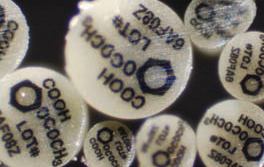 Excipient and coating specialist Colorcon has teamed up with ARmark to provide an authentication technology that can be incorporated into the film coatings of solid oral dosage forms.
Excipient and coating specialist Colorcon has teamed up with ARmark to provide an authentication technology that can be incorporated into the film coatings of solid oral dosage forms.
The two players say the technology - dubbed mark On-Dose ID - falls firmly into the scope of the draft guidance from the US Food and Drug Administration (FDA) on regulatory filing requirements for physical-chemical identifiers (PCIDs) used for anticounterfeiting.
ARmark has developed covert micro-tags that can be integrated into existing film coating processes and carry information such as lot and batch numbers, logos and other text, patterns, shapes and symbols, in a particle just 75-110 microns across.
The micro-tags can be added to dosage forms without additional manufacturing steps or capital investments, according to the companies, and make it possible to detect and authenticate legitimate dosage forms and identify counterfeits using a simple microscope.
They can also be placed onto primary and secondary packaging, making it possible to build a multilayered anti-counterfeiting approach, and are "nearly impossible" to replicate or reverse engineer, they claim.
Meanwhile, Colorcon's pigments, flavours and inks have been used to create film coatings that impart a distinctive appearance to solid dosage forms making it easier for a patient or pharmacists to identify the product at a glance.
The draft PCID guidance was published in July and is designed to remove some of the uncertainty faced by drugmakers using markers to differentiate their products from counterfeits.
It contains practical recommendations, for example, noting that PCIDs should be pharmacologically-inactive and relatively inert. Also, they should be placed in a portion of the dosage form away from the active ingredient and separated from any excipients which affect the active's release profile.
ARmark maintains its micro-tags fulfil the requirements of the draft guidance perfectly.
“Adding mark micro-tags to an existing immediate release film coated tablet can now be considered to be a SUPAC Level 1 annual reportable change,” states Jeff Robertson, director and general manager at the company.
“That means drug manufacturers can quickly begin using the On-Dose ID technology to protect their product without prior approval from the FDA.”
Under FDA guidelines, a SUPAC Level 1 change is a minor modification that needs no individual notification and would simply need to be documented in a company's next annual report.
"Colorcon’s studies have shown there is no impact on dissolution or stability when the mark On-Dose ID micro-tags are incorporated into an existing film-coated dosage form," commented Dr. Kamlesh Oza, Colorcon's general manager of film coatings.
©
SecuringIndustry.com




 Excipient and coating specialist Colorcon has teamed up with ARmark to provide an authentication technology that can be incorporated into the film coatings of solid oral dosage forms.
Excipient and coating specialist Colorcon has teamed up with ARmark to provide an authentication technology that can be incorporated into the film coatings of solid oral dosage forms.